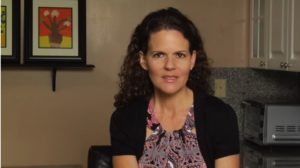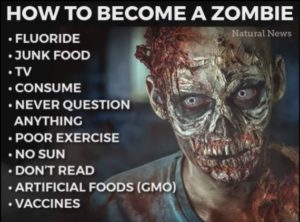
Is there anybody who is NOT calling out the media on their lies these days?
https://prepforthat.com/award-winning-climate-change-researcher-slams-media/
The Bard Said
Zombie Apocalypse
New Seaman
The grumpy Navy Master Chief saw a new face and shouted at him, “Come here! What’s your name, sailor?”
“James,” the new seaman answered.
“Listen carefully sailor, I don’t know what kind of bleeding-heart pansy crap they’re teaching sailors in boot camp these days, but I don’t call anyone by his first name,” the chief scowled. “It their last names only; Carter,Davidson,Cooper, Jackson, whatever. And you are to refer to me as ‘Master Chief.’ Do I make myself clear?”
“Aye, Aye, Master Chief!”
“Now,what’s your last name?”
The sailor sighed. “Darling, My name is James Darling, Master Chief.”
“Okay,James, here’s what I want you to do…”
Evidence mounts that PLAGUE outbreak in Africa is an engineered depopulation bioweapon
What Do Dying Gorillas Have To Do With You and Me?
Al Sears, MD
11905 Southern Blvd.
Royal Palm Beach, FL 33411
November 7, 2017
Tom,
All the gorillas were dying…
Over 50 years of trying to breed gorillas in zoos and nothing was working. It didn’t matter where they tried — San Diego, Cincinnati, St. Louis — not even the best zoos in the country could get these gorillas to reproduce.
They were facing extinction.
And everyone simply accepted that it was impossible to breed gorillas in zoos.
That was until one caretaker took a closer look at what the gorillas were eating. For decades, zoos fed the gorillas what they called gorilla biscuits.
But, on top of being unable to reproduce, the gorillas were developing diseases like heart disease, diabetes, obesity and high blood pressure.
In short, gorillas were not made to eat “biscuits.”
It’s a bit scary to think how you and I find ourselves in a similar situation.
I see it more and more in my clinic patients every year. People are getting sick. They’re struggling with weight, diabetes, heart disease… the list goes on and on.
And the only answer they can get from mainstream doctors is that it’s genetic.
Well I’m here to tell you, just like the gorillas, there is nothing wrong with you. You were made perfect. But the world you live in was not. And you are suffering from today’s abnormal environment.
Mainstream medicine has failed you. They can’t see that every chronic disease is connected by this one common thread that I call Syndrome Zero.
And the biggest culprit is the massive overload of starches in our industrialized, processed, grain-based Western diet. The nutrition-less, modern food supply has wrecked our metabolisms and made our body’s react in a way nature never intended.
Syndrome Zero begins with too much insulin which hijacks your metabolism into making too much fat. It robs your cells of energy. So our cells get weak and our bodies get sick.
You can take back your health and reverse Syndrome Zero, but you have to take action today.
The best step you can take right now is starting my Zero diet. A Zero diet will help return your body to its natural healthy state.
Reverse Syndrome Zero with a Zero Diet
When I work with patients, I don’t focus on lowering blood sugar. Instead, I help my patients improve insulin receptors that have been overwhelmed with a bad diet. For that, I recommend the Zero diet.
A Zero diet is moderate in protein, very high in fat and very low in carbohydrates. When you eat this way carbs don’t trigger insulin.
A Zero diet is your first line of defense against Syndrome Zero. Here are the basic guidelines:
Zero Glycemic. The glycemic index (GI) measures how the carbohydrates in foods increase your blood sugar. Foods with a high GI will spike your blood sugar. Foods with a low GI have carbohydrates that break down slowly, releasing a more manageable trickle of glucose into your bloodstream. On the Zero diet you can eat as many foods with a zero rating on the GI as you want. Here are all the vegetables with a zero score:
Eggplant Asparagus
Snow peas Cabbage
Artichokes Cucumber
Peppers Cauliflower
Spinach Zucchini
Mushroom Celery
Summer squash Lettuce
Broccoli
Choose the right fats. Strictly avoid trans fats and vegetable oils like corn, sunflower, safflower, soy and canola. Instead, choose fats like olive oil, coconut oil, avocado, butter, ghee and heavy cream.
I also recommend MCT (medium chain triglycerides) oil for a zero diet. Your liver converts it directly into energy. My favorite is coconut oil. You can use it to make mayonnaise and salad dressings, or add it to smoothies.
Eat the right protein. Beef, shellfish, organ meats, fish, and eggs are your best sources of protein. If possible, eat grass-fed beef and wild-caught fish. Choose eggs from pastured chicken. Other good sources of protein include chicken, turkey, wild-caught salmon and other cold-water fish. Nuts and seeds such as almonds, peanuts, cashews, sunflower and pumpkin seeds also have plenty of protein.
To Your Good Health,
Al Sears, MD, CNS
P.S. The Zero diet is your first step toward living Syndrome Zero-free, but there are many more. To discover your next steps in reversing this pandemic, watch my free video series: Syndrome Zero: The Root of All Chronic Disease. Click here to register now.
https://marketing.alsearsmd.com/acton/ct/28028/s-0206-1711/Bct/l-01c1/l-01c1:4921e/ct1_0/1?sid=TV2%3AiiBInJlYi
Breast Feeding – Some Interesting Data
“A ‘cold’, a viral infection, or anything that disturbs immune responses can result in subtle changes in the gram negative bacterial flora of the the gut, stimulating them to produce endotoxin. This is absorbed into the blood stream, not adequately detoxified, and results in inflammatory responses in the mucous membrane linings of the middle ear… …that endotoxin is the initial cause of the inflammatory response in acute otitis media…. …Dr Robert Reisinger in America had first alerted me to this group of substances and their relationship to SIDS……The reason why proper breast-feeding provides a known and large amount of protection against otitis media becomes obvious. Breast-feeding tends to prevent the overgrowth of abnormal forms of intestinal organisms that tend, under certain conditions, to produce endotoxin… …Finally, there are two substances that are known to be effective as rapid detoxifiers of endotoxin – Vitamin C and erythromycin -they are both in ‘Archie’s triple injection’. The relationship between SIDS, sudden unexplained shock, sudden unexplained unconsciousness, and otitis media is worthy of consideration. If endotoxin is the ‘cause’ of otitis and also the ‘cause’ of SIDS, sudden unexplained unconsciousness and unexplained shock — as I now know (at least there is a association), then otitis media should be found in a significant number of SIDS cases. That this is so is clearly demonstrated in a number of reported studies. ” Dr Archie Kalokerinos MD (p311 Medical Pioneer)
“One bottle of formula is enough to change a baby’s gut dramatically, and it takes two weeks of breastfeeding to return the gut back to normal. (Personal communication, Dr Robert Reisinger) How can this happen? E Coli is the main culprit. This bacteria is a putrefactive protein loving bacteria. The protein content of human breast milk is lower than in any other mammal, and the protein content of formula or any other milk supplement has a direct influence on the numbers of E Coli in the gut . Not only does the acid gut and very low protein content of breastmilk provide a more hostile environment for E Coli, but breastmilk also contain neutralising factors against E Coli.
Several studies have shown that babies who died of SIDS have a high prevalence of E Coli in the flora of the gut. Some suggest that the E coli “have acquired a plasmid which confers toxigenicity” (Med J Aust, 1989, Vol 151, pg 538) But E. Coli is intrinsically toxic. The outer coating (lipopolysaccharide) is the toxic component, but the key to the toxicity level is the speed with which it can multiply, given the right circumstances. These factors include bottle feeding (which results inmore gram negative bacteria, and a protein and alkaline level favouring E Coli), stress, overheating, viruses, vitamin deficiencies AND the suppressive actions of vaccines on the reticuloendothelial system.
In 1974, Dr Robert Reisinger presented a paper at an International SIDS conference. He quoted many authors who found SIDS predominantly among bottle-fed babies. Included in the authors quoted (but not referenced) was Shirley Tonkin from New Zealand:
“Tonkin reported that in her series of 86 SIDS cases, only two were breast-fed. Since twenty-five percent of her control population were breast fed, she should have had 21 cases of SIDS in breast-fed infants if the risk were the same in both breast-fed and bottle-fed.”
“Coombs stated that if SIDS were relatively as common in the breast-fed as in the bottle-fed infant he should have had 17 breast-fed cases in his series, whereas at that time he had not one.” Hilary Butler
3 Cloud Trends to Watch Out for in 2018

Cloud computing has dominated the business world this year, and the trend will only continue into 2018.
https://www.webpronews.com/3-cloud-trends-watch-2018-2017-11/
Cryptocurrrency Dramas
Pretty sure I don’t like the idea of a programmer’s bug wiping out my cash deposits…
https://www.theguardian.com/technology/2017/nov/08/cryptocurrency-300m-dollars-stolen-bug-ether?CMP=share_btn_gp
How To Prep Grains and Legumes for Maximum Nutrition

A comprehensive video explaining why and demonstrating how to prepare your grains and legumes prior to cooking.
https://www.youtube.com/watch?v=nX3RcU5Hhqg



